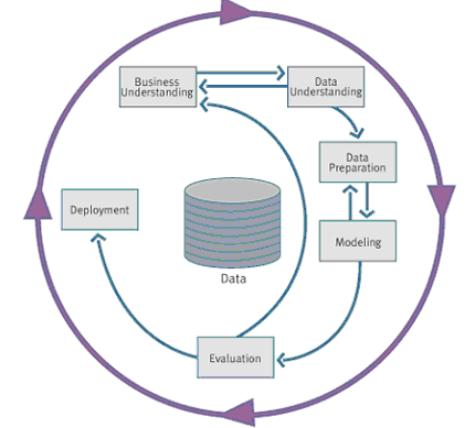Organizational and human factors in Data Mining. Data Mining Standards We considered the Data Mining process from two sides: as a sequence of stages and as a sequence of works.
Organizational and human factors in Data Mining. Data mining standards
We considered the Data Mining process from two sides: as a sequence of stages and as a sequence of works performed by Data Mining roles.
There is another side – these are the standards that describe the Data Mining methodology. The latter consider the organization of the Data Mining process and the development of Data Mining systems.
CRISP-DM [100] (The Cross Industry Standard Process for Data Mining) is the most popular and widespread methodology. The members of the CRISP-DM consortium are NCR, SPSS and DaimlerChrysler.
According to the CRISP standard, Data Mining is an ongoing process with many cycles and feedbacks..
Data Mining according to the CRISP-DM standard includes the following phases:
- Business understanding.
- Data understanding.
- Data preparation
- Modeling
- Evaluation of results (Evaluation).
- Implementation.
A seventh step is sometimes added to this set of phases – Control, it completes the circle. The phases of Data Mining according to the CRISP-DM standard are shown in fig. 21.2.

With the help of the CRISP-DM methodology, Data Mining is transformed into a business process, during which Data Mining technology focuses on solving specific business problems. The CRISP-DM methodology, which was developed by experts in the Data Mining industry, is a step-by-step guide that defines tasks and goals for each stage of the Data Mining process.
The CRISP-DM methodology is described in terms of hierarchical process modeling [101], which consists of a set of tasks described by four levels of generalization (from general to specific): phases, general tasks, specialized tasks, and requests.
At the top level, the Data Mining process is organized into a certain number of phases, at the second level, each phase is divided into several common tasks. The tasks of the second level are called general, because they are the designation (planning) of rather broad tasks that cover all possible Data Mining situations. The third level is task specialization level, i.e. the place where the actions of general tasks are transferred to specific specific situations. The fourth level is report on actions, decisions and results of the actual use of Data Mining.
CRISP-DM is not the only standard that describes the Data Mining methodology. In addition to it, you can apply such well-known methodologies that are world standards as Two Crows, SEMMA, as well as organization methodologies or your own.
